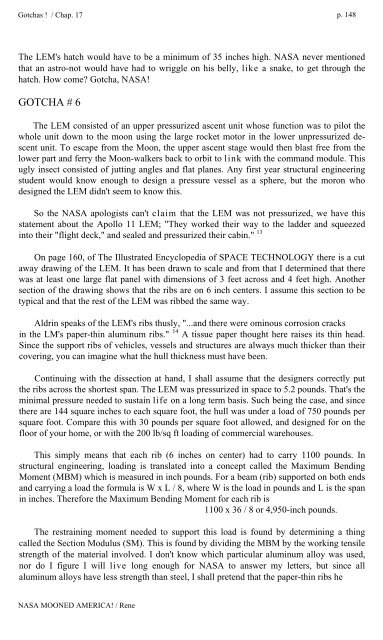Rene-NASA-Mooned-America
Rene-NASA-Mooned-America
Rene-NASA-Mooned-America
You also want an ePaper? Increase the reach of your titles
YUMPU automatically turns print PDFs into web optimized ePapers that Google loves.
Gotchas ! / Chap. 17 p. 148<br />
The LEM's hatch would have to be a minimum of 35 inches high. <strong>NASA</strong> never mentioned<br />
that an astro-not would have had to wriggle on his belly, like a snake, to get through the<br />
hatch. How come Gotcha, <strong>NASA</strong>!<br />
GOTCHA # 6<br />
The LEM consisted of an upper pressurized ascent unit whose function was to pilot the<br />
whole unit down to the moon using the large rocket motor in the lower unpressurized descent<br />
unit. To escape from the Moon, the upper ascent stage would then blast free from the<br />
lower part and ferry the Moon-walkers back to orbit to link with the command module. This<br />
ugly insect consisted of jutting angles and flat planes. Any first year structural engineering<br />
student would know enough to design a pressure vessel as a sphere, but the moron who<br />
designed the LEM didn't seem to know this.<br />
So the <strong>NASA</strong> apologists can't claim that the LEM was not pressurized, we have this<br />
statement about the Apollo 11 LEM; "They worked their way to the ladder and squeezed<br />
into their "flight deck," and sealed and pressurized their cabin." 13<br />
On page 160, of The Illustrated Encyclopedia of SPACE TECHNOLOGY there is a cut<br />
away drawing of the LEM. It has been drawn to scale and from that I determined that there<br />
was at least one large flat panel with dimensions of 3 feet across and 4 feet high. Another<br />
section of the drawing shows that the ribs are on 6 inch centers. I assume this section to be<br />
typical and that the rest of the LEM was ribbed the same way.<br />
Aldrin speaks of the LEM's ribs thusly, "...and there were ominous corrosion cracks<br />
in the LM's paper-thin aluminum ribs." 14 A tissue paper thought here raises its thin head.<br />
Since the support ribs of vehicles, vessels and structures are always much thicker than their<br />
covering, you can imagine what the hull thickness must have been.<br />
Continuing with the dissection at hand, I shall assume that the designers correctly put<br />
the ribs across the shortest span. The LEM was pressurized in space to 5.2 pounds. That's the<br />
minimal pressure needed to sustain life on a long term basis. Such being the case, and since<br />
there are 144 square inches to each square foot, the hull was under a load of 750 pounds per<br />
square foot. Compare this with 30 pounds per square foot allowed, and designed for on the<br />
floor of your home, or with the 200 lb/sq ft loading of commercial warehouses.<br />
This simply means that each rib (6 inches on center) had to carry 1100 pounds. In<br />
structural engineering, loading is translated into a concept called the Maximum Bending<br />
Moment (MBM) which is measured in inch pounds. For a beam (rib) supported on both ends<br />
and carrying a load the formula is W x L / 8, where W is the load in pounds and L is the span<br />
in inches. Therefore the Maximum Bending Moment for each rib is<br />
1100 x 36 / 8 or 4,950-inch pounds.<br />
The restraining moment needed to support this load is found by determining a thing<br />
called the Section Modulus (SM). This is found by dividing the MBM by the working tensile<br />
strength of the material involved. I don't know which particular aluminum alloy was used,<br />
nor do I figure I will live long enough for <strong>NASA</strong> to answer my letters, but since all<br />
aluminum alloys have less strength than steel, I shall pretend that the paper-thin ribs he<br />
<strong>NASA</strong> MOONED AMERICA! / <strong>Rene</strong>


